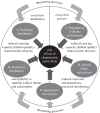A practical guide to the application of the IUCN Red List of Ecosystems criteria
- PMID: 25561664
- PMCID: PMC4290417
- DOI: 10.1098/rstb.2014.0003
A practical guide to the application of the IUCN Red List of Ecosystems criteria
Abstract
The newly developed IUCN Red List of Ecosystems is part of a growing toolbox for assessing risks to biodiversity, which addresses ecosystems and their functioning. The Red List of Ecosystems standard allows systematic assessment of all freshwater, marine, terrestrial and subterranean ecosystem types in terms of their global risk of collapse. In addition, the Red List of Ecosystems categories and criteria provide a technical base for assessments of ecosystem status at the regional, national, or subnational level. While the Red List of Ecosystems criteria were designed to be widely applicable by scientists and practitioners, guidelines are needed to ensure they are implemented in a standardized manner to reduce epistemic uncertainties and allow robust comparisons among ecosystems and over time. We review the intended application of the Red List of Ecosystems assessment process, summarize 'best-practice' methods for ecosystem assessments and outline approaches to ensure operational rigour of assessments. The Red List of Ecosystems will inform priority setting for ecosystem types worldwide, and strengthen capacity to report on progress towards the Aichi Targets of the Convention on Biological Diversity. When integrated with other IUCN knowledge products, such as the World Database of Protected Areas/Protected Planet, Key Biodiversity Areas and the IUCN Red List of Threatened Species, the Red List of Ecosystems will contribute to providing the most complete global measure of the status of biodiversity yet achieved.
Keywords: IUCN Red List of Ecosystems; ecosystem conservation; ecosystem risk assessment; ecosystem types; risk of collapse; threatened ecosystems.
© 2015 The Author(s) Published by the Royal Society. All rights reserved.
Figures






Similar articles
-
Scientific foundations for an IUCN Red List of ecosystems.PLoS One. 2013 May 8;8(5):e62111. doi: 10.1371/journal.pone.0062111. Print 2013. PLoS One. 2013. PMID: 23667454 Free PMC article.
-
Contributions of the IUCN Red List of Ecosystems to risk-based design and management of protected and conserved areas in Africa.Conserv Biol. 2024 Jun;38(3):e14169. doi: 10.1111/cobi.14169. Epub 2024 Mar 15. Conserv Biol. 2024. PMID: 37650432
-
Quantification of extinction risk: IUCN's system for classifying threatened species.Conserv Biol. 2008 Dec;22(6):1424-42. doi: 10.1111/j.1523-1739.2008.01044.x. Epub 2008 Sep 25. Conserv Biol. 2008. PMID: 18847444 Review.
-
Establishing IUCN Red List criteria for threatened ecosystems.Conserv Biol. 2011 Feb;25(1):21-9. doi: 10.1111/j.1523-1739.2010.01598.x. Epub 2010 Nov 5. Conserv Biol. 2011. PMID: 21054525 Free PMC article.
-
Roles of the Red List of Ecosystems in the Kunming-Montreal Global Biodiversity Framework.Nat Ecol Evol. 2024 Apr;8(4):614-621. doi: 10.1038/s41559-023-02320-5. Epub 2024 Feb 8. Nat Ecol Evol. 2024. PMID: 38332025 Review.
Cited by
-
Systematic review of the uncertainty of coral reef futures under climate change.Nat Commun. 2024 Mar 12;15(1):2224. doi: 10.1038/s41467-024-46255-2. Nat Commun. 2024. PMID: 38472196 Free PMC article.
-
Beyond central-tendency: If we agree discrete vegetation communities do not exist, should we investigate other methods of clustering?Ecol Evol. 2023 Nov 20;13(11):e10757. doi: 10.1002/ece3.10757. eCollection 2023 Nov. Ecol Evol. 2023. PMID: 38020702 Free PMC article.
-
Multi-temporal ecological niche modeling for bird conservation in the face of climate change scenarios in Caatinga, Brazil.PeerJ. 2023 Feb 27;11:e14882. doi: 10.7717/peerj.14882. eCollection 2023. PeerJ. 2023. PMID: 36874965 Free PMC article.
-
Shifting headlines? Size trends of newsworthy fishes.PeerJ. 2019 Feb 15;7:e6395. doi: 10.7717/peerj.6395. eCollection 2019. PeerJ. 2019. PMID: 30783570 Free PMC article.
-
Vulnerability Assessment of Six Endemic Tibetan-Himalayan Plants Under Climate Change and Human Activities.Plants (Basel). 2025 Aug 5;14(15):2424. doi: 10.3390/plants14152424. Plants (Basel). 2025. PMID: 40805772 Free PMC article.
References
-
- Dirzo R, Raven PH. 2003. Global state of biodiversity and loss. Annu. Rev. Environ. Resour. 28, 137–167. (10.1146/annurev.energy.28.050302.105532) - DOI
-
- Mace G, et al. 2005. Biodiversity. In Ecosystems and human well-being: current state and trends, vol. 1 Findings of the Condition and Trends Working Group (eds Hassan R, Scholes R, Ash N.), pp. 77–122. Washington, DC: Island Press.
-
- Rodríguez JP, et al. 2012. IUCN Red List of Ecosystems. SAPIENS. 2012 5.2. http://sapiens.revues.org/1286 .
-
- IUCN. In press. IUCN Red List of Ecosystems guidebook: categories, criteria and how to apply them, version 1. Gland, Switzerland: Ecosystems Red List Thematic Group, Commission on Ecosystem Management (CEM) and Global Ecosystem Management Programme (GEMP), International Union for Conservation of Nature (IUCN).
Publication types
MeSH terms
LinkOut - more resources
Full Text Sources
Other Literature Sources

